Treatment and maintenance of disease, weak and residual seedlings of orchids
Sometimes the orchid seedlings purchased from the market are not satisfactory, and even some orchid seedlings are sick, weak and residual seedlings, which can be treated through some maintenance methods to restore the healthy growth of orchid seedlings.
First, trim the Langen. Cut off the rotten, empty, and black root from the fresh tissue at the top of the root, pull it down, leaving the central column (with a weak supply of nutrition). After the root treatment is finished, the dead protective leaves on the edge of the bulb (this tissue mainly escorts the growth of new buds, and most of them die gradually after growing up) are carefully pulled off toward the leaf tip so as not to hide bacteria, and rinse the sediment and other residues between the bulbs.
Soak the orchid seedlings in 800-1000 methyloxylate or potassium permanganate solution for more than 20 minutes, not more than 1 hour. Then pick up the orchid seedlings and put them in a cool and ventilated place to dry.
After basic drying, the leaves, bulbs and roots of orchid were sprayed with a mixture of penicillin and agricultural streptomycin, and then sprayed with the remaining solution of previously soaked orchid seedlings.
Sift out two types of weathered rock as matrix, large as soybeans and small as mung beans. Plant the large weathered rock to about 10 cm at the mouth of the basin, and then fill in the small weathered rock. Because the plant material is all-vegetarian, the orchid seedlings can be planted deeper for moisturizing. After pouring the fixed root water, it is maintained in a place with high shade and slight ventilation. Usually pay attention to spray moisturizing, topsoil and leaves to maintain high humidity, basin soil to keep slightly moist, less watering to facilitate root. Usually spray foliar fertilizer to promote root.
After about 3-6 months, most of the orchid seedlings have already sprouted and rooted, and at least one new bud can be turned into a mature seedling before turning the pot and changing the soil. Sift the weathered rocks in the basin again, leaving the coarse particles to mix with the immortal soil, and use at least half of the soil to inoculate blue bacteria. The use of this kind of fertilizer is not only safe, but also can provide certain nutrients to the newly rejuvenated orchid seedlings.
In the future, the pot will be turned over year by year, and the fertilizer of plant material will be allocated according to the situation of seedling and root. In general, the stronger the root and seedling is, the thicker the plant material is, and the weaker the root and seedling is, then the cultured soil should be plain and fine.
In order to maintain sick, weak and residual seedlings, we must pay attention to ensuring that the air humidity is higher and the soil moisture is lower. Normal insect control and sterilization, the light should not be too strong, lest the foliar moisture loss is too fast and the root is not healthy, unable to supply water normally, leading to dehydration. Absolutely not random fertilization, can only often spray some blue bacteria king, potassium dihydrogen phosphate and other foliar root fertilizer to ensure its normal growth and development.
Related
- Is the orchid suitable for indoor use? Is it good for the body?
- How to prevent the empty root of orchids?
- What to do after the crab claw orchid is withered?
- Why are the leaves of orchids always yellow? Fertilizing and watering.
- Can the root of the gentleman orchid be saved if it is rotten?
- Diagnosis and treatment of cotton-blowing beetle insects in Cymbidium
- There is a way for a gentleman's orchid to rot.
- What is the most suitable temperature and humidity for the orchid?
- How to raise a gentleman's orchid? Cultivation techniques of Cymbidium
- How to prepare the nutritive soil for the cultivation of Cymbidium



